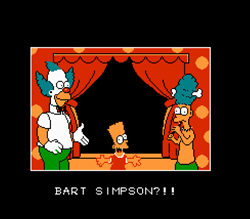 What’s so wrong with Monty Burns?
What’s so wrong with Monty Burns?
Today’s game is The Simpsons: Bart Vs. the World. It’s the direct sequel to The Simpsons: Bart vs. the Space Mutants, and it’s another Acclaim title that puts the “crap” in “craptacular”. This go-around, Bart has dropped all the adventure game-lite trappings of the previous title, and all the action in Vs. the World is wholly based on platforming challenges and boss fights. There are a few puzzles littered here and there, but it’s much more “find this doodad” and not “use spray paint on trashcan” like in Vs. the Space Mutants. As a result, Vs. the World feels somehow… dumber than its predecessor. And, what’s worse, for the reemphasis on platforming and action set pieces (you skateboard down the Great Wall of China!), nobody thought to improve the atrocious controls of Vs. The Space Mutants, so those “platforming challenges” are very likely to be the death of your favorite Simpsons character (Bart, to be clear, not Disco Stu). Basically, the one unique part of Vs. the Space Mutants got dropped, and all we’re left with is that inscrutable “hold jump to run” nonsense.
But Bart vs. the World does have one advantage over Bart vs. the Space Mutants: It’s actually a Simpsons game. Like Fester before him, Vs. the Space Mutants forces Bart to battle aliens who presumably want to abduct some cows, man. And they’re not even Kang & Kodos! They’re just generic aliens (occasionally mutating forms through the different ports). Meanwhile, Bart vs. the World might see Bart up against the world, but it’s a world seemingly controlled by Homer Simpson’s boss, C. Montgomery Burns. This strangely convoluted plot involves Bart entering a drawing contest on The Krusty the Clown Show, winning thanks to Burns’ meddling, and then being sent on a trip around the world wherein Burns can destroy the “despised” Simpsons family. 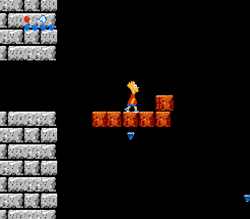 This, naturally, raises a lot of questions, as… what is the goal here? Burns has to kill one of his employees’ children internationally, or it doesn’t count? Oh, wait, the last stop on the trip is Hollywood, so that doesn’t even work. Maybe Burns’ various assassins don’t want to go anywhere near the Springfield Tire Fire, so they’re scattered about the globe. Or maybe Burns just doesn’t want to spring for airfare for any killers, and shipping one Simpson family around is cheaper. Whatever the case, Bart is on an international scavenger hunt for Krusty brand merchandise, and Burns is trying to kill him all the while.
This, naturally, raises a lot of questions, as… what is the goal here? Burns has to kill one of his employees’ children internationally, or it doesn’t count? Oh, wait, the last stop on the trip is Hollywood, so that doesn’t even work. Maybe Burns’ various assassins don’t want to go anywhere near the Springfield Tire Fire, so they’re scattered about the globe. Or maybe Burns just doesn’t want to spring for airfare for any killers, and shipping one Simpson family around is cheaper. Whatever the case, Bart is on an international scavenger hunt for Krusty brand merchandise, and Burns is trying to kill him all the while.
Which raises the question: if you had to pull a villain out of The Simpsons, why Burns?
At this point in the franchise, you can’t blame the source material. This videogame was released in 1991, and only had a solid two seasons of The Simpsons to draw from. And, in that batch of episodes, there were only a handful where Burns was the antagonist. In Simpsons Roasting on an Open Fire, Burns is a “villain”, but only because he won’t grant Homer and other “unskilled workers” a Christmas Bonus. From there, we’ve got Homer’s Odyssey, where Homer is fired for nearly causing a nuclear meltdown… which, let’s be honest, sounds like a pretty reasonable reason for termination. And that’s about it for Burns being a “villain” in Season 1. Babysitters are more of a threat!
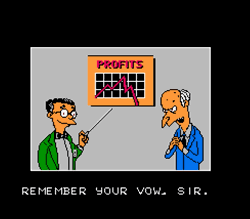 Season 2 of The Simpsons ramps up Burns to full-blown antagonism levels, but we’re still nowhere near murderous. Three Eyes in Every Fish sees Burns running for governor after his plant poisons the local water supply, but, big deal, that’s been the Republican MO for the last few decades. Then Bart Gets Hit by a Car, but that was an accident, and more of a parable about not overreaching when trying to shake down the filthy rich. Brush With Greatness is the story of how Burns has an incredibly nonthreatening penis, and the Season 2 finale (which likely wasn’t even available when Bart vs. the World was being produced) is Blood Feud, wherein Homer goes nuts over Burns not being generous after receiving a blood transfusion. Again, we’re in a situation where Homer expects more than his boss has to give, and the central conflict is that Burns is appreciative, but not appreciative enough.
Season 2 of The Simpsons ramps up Burns to full-blown antagonism levels, but we’re still nowhere near murderous. Three Eyes in Every Fish sees Burns running for governor after his plant poisons the local water supply, but, big deal, that’s been the Republican MO for the last few decades. Then Bart Gets Hit by a Car, but that was an accident, and more of a parable about not overreaching when trying to shake down the filthy rich. Brush With Greatness is the story of how Burns has an incredibly nonthreatening penis, and the Season 2 finale (which likely wasn’t even available when Bart vs. the World was being produced) is Blood Feud, wherein Homer goes nuts over Burns not being generous after receiving a blood transfusion. Again, we’re in a situation where Homer expects more than his boss has to give, and the central conflict is that Burns is appreciative, but not appreciative enough.
Yet Bart vs. the World portrays Burns as wholly homicidal. And if we’re going to include The Simpsons Arcade Game (released the same year), we’ve got a Burns that kidnaps babies and launches nuclear bombs. That’s a significant escalation from “sent a pleasant thank you note”!
So what happened here? Why, in only The Simpsons’ second year, did videogames promote Burns from “bad boss” to “genocidal madman”?
Well, it probably speaks to videogame producers identifying what The Simpsons was initially about.
After 20 some seasons and over 600 episodes, it’s hard to remember that The Simpsons started during the 80s/90s wave of blue-collar style sitcoms. After years of high concept situation comedies like “what if people were trapped on a desert island”, “what if they’re creepy and they’re kooky”, or even “what if a woman had a decent job”, The Simpsons rode in on a wave of programs like Roseanne or Married… With Children wherein the protagonists faced very real problems. No more did people worry about magical girl wives or whether they were secretly the dream of Bob Newhart; this new wave of sitcoms derived humor from upsetting real world situations, 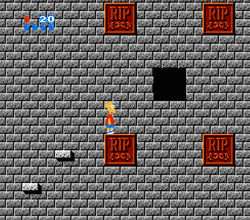 like teenage pregnancy, hiding from your landlord, or gradually falling out of favor with your spouse. And the biggest, realest problem of all? Money! The world is a cold, harsh place, and your family is never going to love you if you can’t bring home a host of Christmas presents. There are jokes along the way, but, once upon a time, every “comedy” out there was expounding the horrors of our collective everyday drudgery.
like teenage pregnancy, hiding from your landlord, or gradually falling out of favor with your spouse. And the biggest, realest problem of all? Money! The world is a cold, harsh place, and your family is never going to love you if you can’t bring home a host of Christmas presents. There are jokes along the way, but, once upon a time, every “comedy” out there was expounding the horrors of our collective everyday drudgery.
And, while The Simpsons did lend itself to whimsy more often than not in those early seasons (Bart winds up making wine on another continent inside of ten episodes), it was still a very grounded, “real” sitcom. …Granted, this might just be because TV Guide was somehow impressed on a weekly basis that Homer didn’t ride a mastodon to work, so the writers deliberately, defiantly veered into “real world” territory just to sunder expectations… But this is still a franchise that officially started with a treatise on commercialism and a family trying to keep it together in the face of financial hardships. And the cause of that financial hardship? It’s Burns. The man who fires Homer a few episodes later? Burns. The old man responsible for injuring a young boy and then never paying for it? Burns. And is showing kindness to a rich white man financially rewarded? No, because you simply can’t win in a world where you’ve been constrained to the lowest rung of the ladder.
Of course Burns is the enemy of the Simpsons. Burns is the enemy of every working-class family.
Burns is money incarnate. Burns has all the power not only in Springfield (like, literally all the power), but he also decides whether Homer lives or dies. Want to keep earning a salary? Have a good Christmas? Lisa needs braces? Well, that dental plan is 100% controlled by one man. Burns doesn’t have to be villainous, he simply is villainous because of his position. He’s the king of the castle, and the Simpson family has to pay him tribute to so much as set up a tent in the courtyard. Burns is, one way or another, the source of all the woes afflicting the Simpsons.
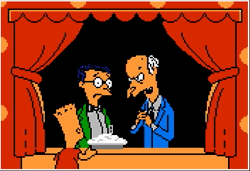 So it’s only natural that transposing that character to other situations would mean he would have to adjust to the medium du jour. When Mr. Burns had to be the antagonist of a NES title, he became murderous and gained an army of generally identical/vaguely racist “family members”. When he had to headline a Konami beat ‘em up, he gained a super suit and explosive weaponry. When The Simpsons itself veered away from “reality” and more into “a cartoon”, Mr. Burns became an appropriately cartoonish supervillain with a penchant for petty antics. Mr. Burns was always the villain, just what is “the villain” had to change between mediums and epochs.
So it’s only natural that transposing that character to other situations would mean he would have to adjust to the medium du jour. When Mr. Burns had to be the antagonist of a NES title, he became murderous and gained an army of generally identical/vaguely racist “family members”. When he had to headline a Konami beat ‘em up, he gained a super suit and explosive weaponry. When The Simpsons itself veered away from “reality” and more into “a cartoon”, Mr. Burns became an appropriately cartoonish supervillain with a penchant for petty antics. Mr. Burns was always the villain, just what is “the villain” had to change between mediums and epochs.
Except Mr. Burns himself never changed. In a 1989 sitcom, he was a rich, old, white (yellow) man. In a 1991 videogame, he was a rich, old, white man. In 2020, he is a rich, old, white man. Through thirty years, right there from his first appearance, he’s been a villain. His actions may have varied across the years, but he’s also been the same, easily identified archetype. He’s a rich, old, white man, and that makes him the natural enemy of the average, middle class family.
Mr. Burns was always going to be the villain. Mr. Burns has always been the villain. And everyone has been able to identify that right from the start.
FGC #485 The Simpsons: Bart vs. the World
- System: Nintendo Entertainment System, but also the Game Gear and Master System a couple of years later. I absolutely do not want to see what this game looks like on the Game Gear.
- Number of players: Just a Bart, man.
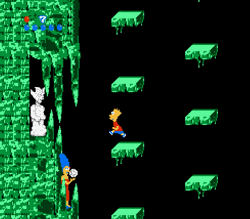 Collect-a-thon: This is another weird, early game featuring collectibles that can alter the course of the game. Every level is hiding a hidden Krusty doodad, and, if you collect them all, you get to play one extra level that is atrocious. It’s supposed to be a Duck Amuck-esque adventure for Bart in an “animated” world… but it’s mostly just a half-baked stage with terrible hit detection… which, granted, is basically the same as the rest of the game. But! If you clear it, you get a secret bonus ending where you can hit Mr. Burns with a pie. Cowabunga!
Collect-a-thon: This is another weird, early game featuring collectibles that can alter the course of the game. Every level is hiding a hidden Krusty doodad, and, if you collect them all, you get to play one extra level that is atrocious. It’s supposed to be a Duck Amuck-esque adventure for Bart in an “animated” world… but it’s mostly just a half-baked stage with terrible hit detection… which, granted, is basically the same as the rest of the game. But! If you clear it, you get a secret bonus ending where you can hit Mr. Burns with a pie. Cowabunga!- Favorite Continent: I guess it’s the final world, Hollywood, as it uses the tinsel town trappings to throw in a whole Halloween level. There’s a skeleton! It’s also, oddly enough, exactly the same excuse for a “horror level” that we saw in Gremlins 2. Was there some Acclaim/Sunsoft overlap?
- It’s Trivia Time: There are various minigames available between levels. The best is Simpsons Trivia, which offers a number of questions regarding esoteric Simpsons knowledge. That makes fans happy! A sliding block puzzle that reminds good little Goggle Bobs of Beyond the Beyond is… less fun.
- Say something nice: The “Bartman” powerup was pretty fun in the ol’ days before flight was shoehorned into every platforming game. It may have only lasted for something like seven seconds, but it’s always nice to have movement unfettered by the laws of gravity.
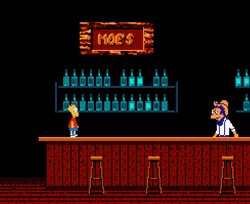 Did you know? Entertainment Weekly designated this title as a “travel-action game”. I would like to see more of this previously unknown genre.
Did you know? Entertainment Weekly designated this title as a “travel-action game”. I would like to see more of this previously unknown genre.- Would I play again: No thank you. Is The Simpsons Arcade Game available? I think that would be my first choice over this mediocre platformer.
What’s next? Random ROB has chosen… Super Mario Land 2 for the Nintendo Gameboy! Everybody do the Mario! Or the Wario! Please look forward to it!
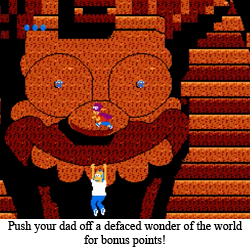

I beat this game twice growing up and actually got that stupid pie in the face bonus. It’s just a static image of burns & smithers, may as well be chucking a pie at a painting of them. Super satisfying.
I’ll say this much for Bart vs. The World: At least Moe looks recognizably like Moe now, unlike the previous NES game.
The cast’s proportions are questionable, though. Moe looks right, but Marge and Homer and the Krusty statue look too small. I get this was an NES game, but they probably could’ve made their sprites a little larger.
[…] is it? Hey, everybody, it’s another Simpsons video game. Try to sound excited! This time, we’ve got a game that was actually penned […]
[…] enterprise leaked into adult entertainment, too. Remember The Critic? An obvious descendent of The Simpsons, and one of the few dittos of the era to actually be funny? A full half of its fifth episode was […]